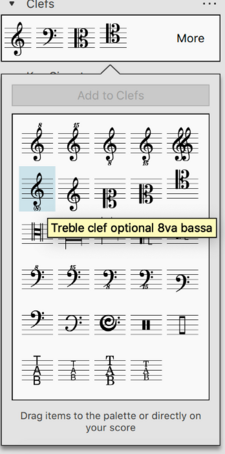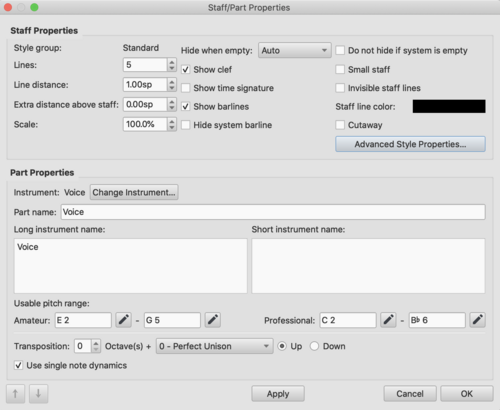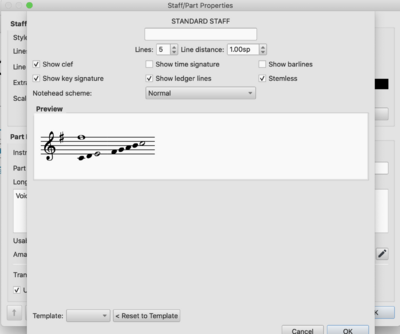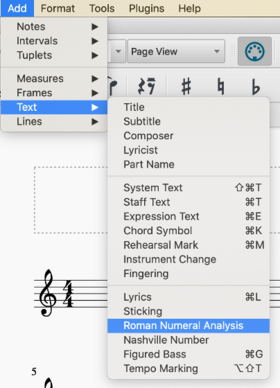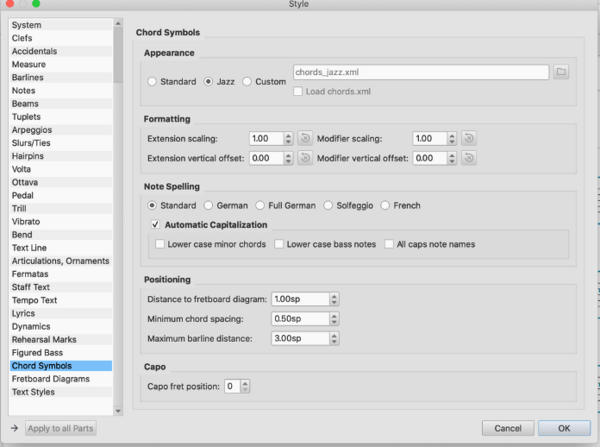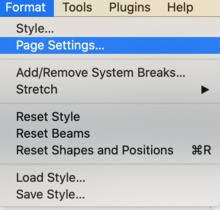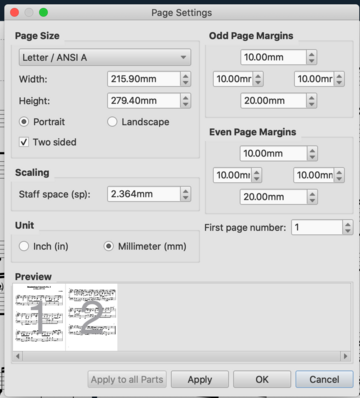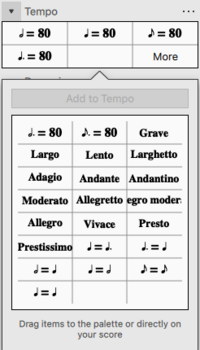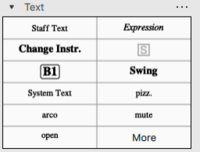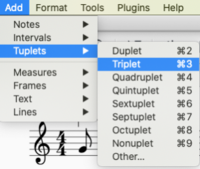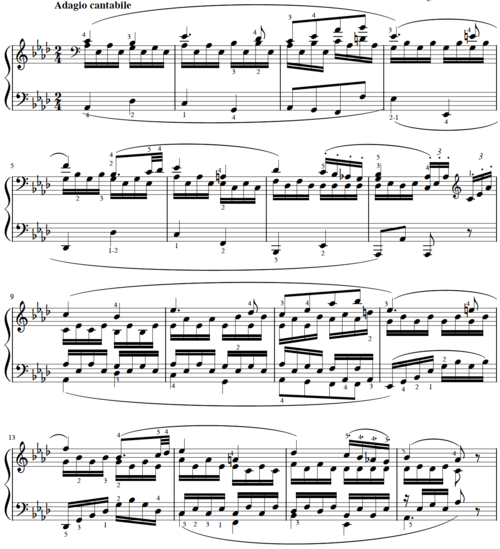Musescore Supplement
Contents
- 1 Using MuseScore in practical academic studies
- 2 Vocal Music in MuseScore
- 2.1 Early Vocal Music
- 2.1.1 Example 1. Chant, "Ubi caritas" (anonymous)
- 2.1.2 Example 2. Two-voice organum: "Kyrie, Cunctipotens genitor"
- 2.1.3 Example 3. Two-voice polyphony: Excerpt from the "Duo Agnus Dei II" of the Missa de Beata Virgine (Josquin des Prez)
- 2.1.4 Example 4. Secular monophony: "Sumer is Icumen in" (anonymous)
- 2.1.5 Example 5. Renaissance polyphony: "Jesu, Rex admirabilis" (Giovanni Pierluigi da Palestrina), open-position score
- 2.1.6 Example 6. Renaissance polyphony: "Jesu, Rex admirabilis" (Giovanni Pierluigi da Palestrina), closed-position score
- 2.2 Baroque-era vocal music in MuseScore
- 2.1 Early Vocal Music
- 3 Instrumental music in MuseScore
- 3.1 Baroque-era instrumental music
- 3.2 Classical/Romantic-era instrumental music
- 3.2.1 Example 13. Symphony No. 41 in C Major ("Jupiter"), K. 551 (W. A. Mozart), arr. for two pianos]
- 3.2.2 Example 14. Piano Sonata No. 8, Op.13 (“Pathétique”), second movement (Ludwig van Beethoven)
- 3.2.3 Example 15. Melody from Symphony No. 9 (Ludwig van Beethoven)
- 3.2.4 Example 16. Nocturne, Op. 9 No. 1 (Fryderyk Chopin)
- 3.3 20th-Century instrumental music
- 4 Exporting MuseScore files
Using MuseScore in practical academic studies
These examples supplement the initial exercises designed the MuseScore unit in Music 253/CS 275A at Stanford University, where our interest is in musical data translation. Given the unusual circumstances we face in the 2020-2021 academic year, Christina Kim has assembled these examples to show the program's possibilities in music theory, practice, and undergraduate studies generally.
Vocal Music in MuseScore
Vocal music often requires the use of more features of notation software than instrumental music does. In this series of examples we represent a broad selection of samples involving features that are surpass those described in beginners' lessons.
Early Vocal Music
Example 1. Chant, "Ubi caritas" (anonymous)
Tools you need:
- Method 1: Choose an instrument (here use "voice," which may or may not automatically add the optional vocal tenor clef on the clef) OR
- Method 2: If not, use “clefs” from the palettes. (click the original clef then double click the treble clef)
User comments:
- Using ¼ for the time signature produces better spacing.
- To produce "ummeasured" chant notation, make the time signature, stems, and the bar lines invisible by selecting All -> staff/part properties -> advanced style properties.
- Review items: Slurs and texts from the “Octaves, Slurs, Fingerings, and Text”
Example 2. Two-voice organum: "Kyrie, Cunctipotens genitor"
- Spacing (Press Enter)
Review features:
- Notes
- Lyrics
- Chant (Hint: Staff/Part Properties)
Example 3. Two-voice polyphony: Excerpt from the "Duo Agnus Dei II" of the Missa de Beata Virgine (Josquin des Prez)
Review features:
- Notes
- Clef changes
- Voices/Layers (necessary for writing two parts on one staff)
- Slurs
Example 4. Secular monophony: "Sumer is Icumen in" (anonymous)
New features:
- Dotted notes & rests
- Spacing – using “Enter” key
Review features:
- Notes and Lyrics
- Rests
Example 5. Renaissance polyphony: "Jesu, Rex admirabilis" (Giovanni Pierluigi da Palestrina), open-position score
New features:
- Choosing Instruments: Choir – Soprano, Alto, and Baritone
- Taking advantage of same rhythmic values
Example 6. Renaissance polyphony: "Jesu, Rex admirabilis" (Giovanni Pierluigi da Palestrina), closed-position score
New features:
- Creating a Closed score
Review topic:
- Multiple layers. See “Voices/Layers”)
Baroque-era vocal music in MuseScore
Example 7. Figured bass in "Dido’s Lament" (Henry Purcell)
New feature:
- Figured Bass – Command+G
Example 8. Roman-numeral analysis figures for "Dido’s Lament" (Henry Purcell)
New feature:
- Roman-numeral analysis symbols from the menu - Add -> Text -> Roman Numeral Analysis
Example 9. Chord symbols added for "Dido’s Lament" (Henry Purcell)
New feature:
- Chord symbol: Add -> Text -> Chord Symbol
N.B. The font can be changed so that it recognizes the superscript by changing the appearance from Standard to Jazz in the Style (use Format from the menu).
Instrumental music in MuseScore
Baroque-era instrumental music
Example 10. Brandenburg Concerto No. 3 in G Major, BWV 1048 (J. S. Bach)
New feature:
- Subdivisions of one note (using layers)
- Shared noteheads
Features reviewed:
- Notes
- Octaves
- Chords
- Voices/Layers
Other refinements
- Parentheses (showing accidentals from the palette)
- Beams (using palette)
- Size adjustment, using Format -> Page Settings -> Scaling (e.g. from 1.764mm to 2.364mm)
Example 11. Minuet in G (Christian Petzold), first phrase
New features:
- Grace Notes, using palette
- Ornaments: add by searching for “Ornaments” in the palette box
Example 12. Minuet in G (Christian Petzold), last phrase
Features reviewed:
- Ornaments
- Chords
- Voices/layers
Classical/Romantic-era instrumental music
Example 13. Symphony No. 41 in C Major ("Jupiter"), K. 551 (W. A. Mozart), arr. for two pianos]
New features:
- Add staccato: Shift+S
- Selecting instruments -> Piano & Piano
- Choosing tempo: (1) select from the palette, then (2) edit text by double-clicking
Features reviewed:
- Fingerings
- System Text: Choose Text from the Palette
- Triplets = Add -> Tuplets -> Triplet (or command/control + 3)
Example 14. Piano Sonata No. 8, Op.13 (“Pathétique”), second movement (Ludwig van Beethoven)
New features:
- Temporary clef change: Drag the clef into the measure (Measure 1 in this case)
- Modify system breaks: Format -> Add/Remove System Breaks
Features reviewed:
- Fingerings
- Tempo setting
Example 15. Melody from Symphony No. 9 (Ludwig van Beethoven)
New feature:
- How to create A, B, endings: Use "Repeat & Jumps" from the palette
Example 16. Nocturne, Op. 9 No. 1 (Fryderyk Chopin)
New feature:
- Expanded use of tuplets: For this example adjust the numbers ratio to apply to eighth notes.
20th-Century instrumental music
Example 17. "The Peacock" from 3 Hungarian Folksongs, Csík (Béla Bartók)
New features:
- New: Crescendo / Decrescendo (Lines from the Palette)
- New: Time Signature (Palette)
- New: Look up "arpeggio" from the Palette, add to your Palette
- New: Tie = select the note(s), press shift and then + key
- New: Double Dots -> Find the "Basic edited" box on the top left corner, change it to "Advanced"
Features reviewed:
- Repeats & Jumps
- Texts (tempo, expression, staff text, tremolo)
- Tuplets
- Accidentals, Articulations
- Beams
- Dynamics and other modifications available as shown below.
Exporting MuseScore files
MuseScore files can be saved or exported to *.xml (MusicXML), *.pdf (Portable Document Format), *.png (Portable Network Graphics), and *.svg (Scalable Vector Graphics).
Most notation formats in current use reliably preserve pitch and rhythmic information but may shed dynamics, ornamentation marks, and lyrics. When we have tested these export formats for the examples above, we had predictable results: those were sometimes missing.
